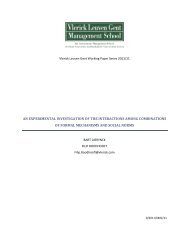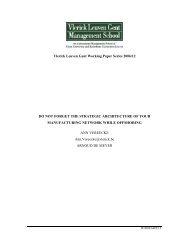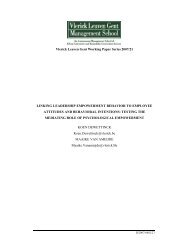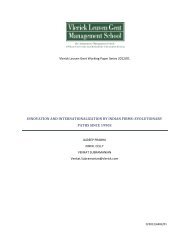Vlerick Leuven Gent Working Paper Series 2007/03 ... - Vlerick Public
Vlerick Leuven Gent Working Paper Series 2007/03 ... - Vlerick Public
Vlerick Leuven Gent Working Paper Series 2007/03 ... - Vlerick Public
You also want an ePaper? Increase the reach of your titles
YUMPU automatically turns print PDFs into web optimized ePapers that Google loves.
INTRODUCTION<br />
Since the mid-1980s, the issue of corporate governance has attracted a great deal of<br />
attention both in academic research and in practice. Shleifer and Vishny (1997) define<br />
corporate governance as “the ways in which suppliers of finance to corporations assure<br />
themselves of getting a return on their investment” (p.737). John and Senbet (1998) propose<br />
the more comprehensive definition that “corporate governance deals with mechanisms by<br />
which stakeholders of a corporation exercise control over corporate insiders and management<br />
such that their interests are protected” (p.372). Since corporate governance has to do with<br />
setting priorities, delegating power and organizing accountability, it receives high priority on<br />
the agenda of policymakers, institutional investors, companies and academics. Recent<br />
American and European corporate scandals (Enron, WorldCom, Ahold etc.) set off a fresh<br />
round of debate. In the wake of these corporate failures, basic principles and rules are being<br />
reviewed and strengthened in order to reinstall investor confidence. At the heart of these<br />
corporate governance reforms is the common interest in the effectiveness of the boards of<br />
directors. This comes as no surprise as Williamson (1985) argued “the board of directors<br />
should be regarded primarily as a governance structure safeguard between the firm and<br />
owners of equity capital” (p.298). Corporate governance codes, experts and activists have<br />
long advocated changes in the board structure. The changes include, among others, the<br />
appointment of independent directors, the installation of board committees in those areas<br />
where conflicts of interest might appear and a separation of the roles of CEO and chairman of<br />
the board (Van den Berghe and De Ridder, 1999). These structural measures are assumed to<br />
be important means to enhance the power of the board, protect shareholders’ interest and<br />
hence increase shareholder wealth (Becht et. al., 2002; Westphal, 1998).<br />
The same issues have also received substantial interest in academic research. Boards<br />
of directors have been the subject of extensive research in diverse disciplines as finance,<br />
economics, management and sociology. Probably one of the most widely discussed issues<br />
concerns how to appropriately structure the board of directors and to what extent changes in<br />
the make up of the board influence performance outcomes. An impressive amount of<br />
empirical research has examined the consequences of different board characteristics, such as<br />
board size (Conyon and Peck, 1998; Yermack, 1996; Provan, 1980), outsider/insider<br />
proportion (Rosenstein and Wyatt, 1990; Kesner, 1987; Baysinger and Butler, 1985) and CEO<br />
duality (Rechner and Dalton, 1991; Donaldson and Davis, 1991) on board or firm<br />
performance.<br />
4










